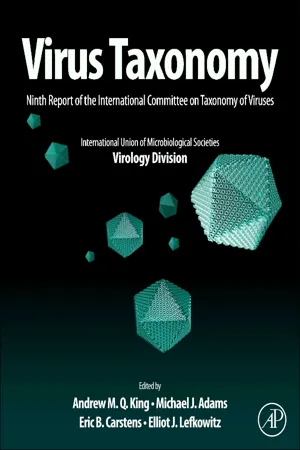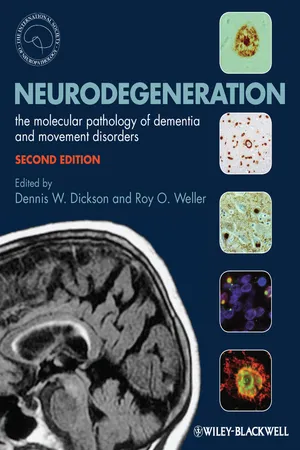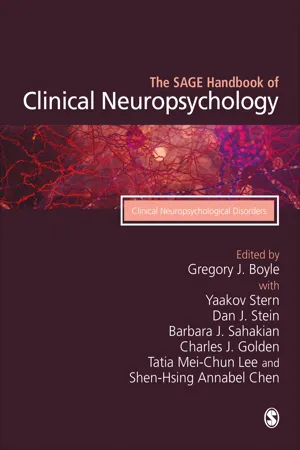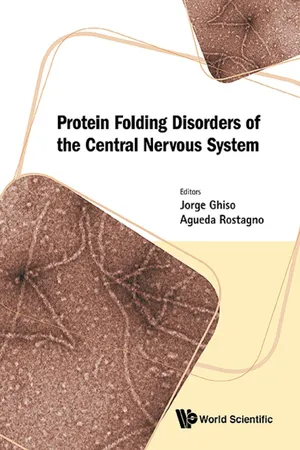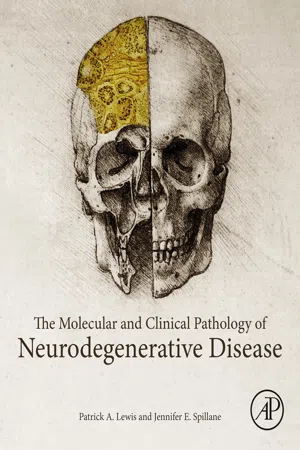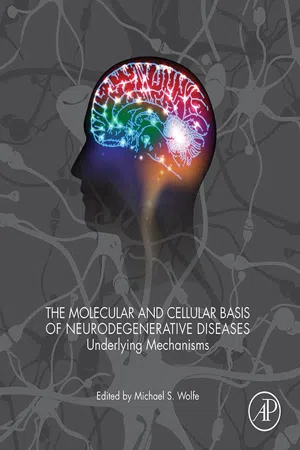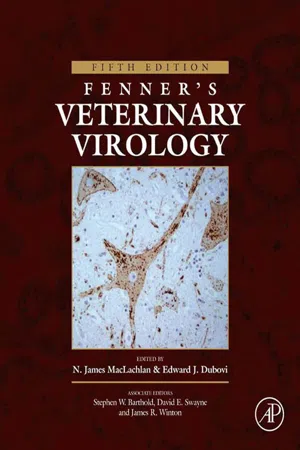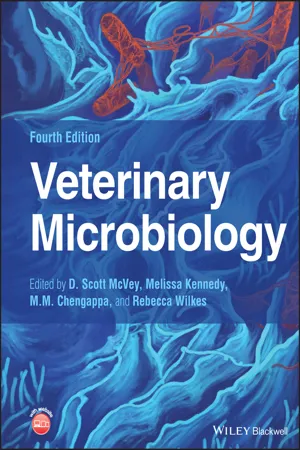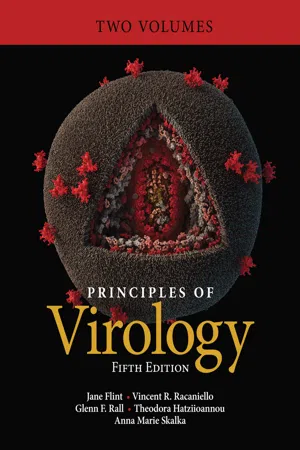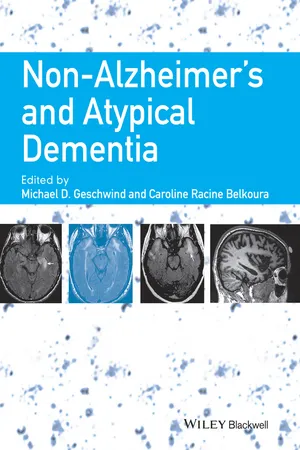Biological Sciences
Prions
Prions are infectious proteins that can cause neurodegenerative diseases in humans and animals. Unlike viruses or bacteria, prions do not contain genetic material but can induce abnormal folding of normal cellular proteins, leading to the formation of toxic aggregates in the brain. This can result in conditions such as Creutzfeldt-Jakob disease, mad cow disease, and scrapie.
Written by Perlego with AI-assistance
Related key terms
Related key terms
1 of 4
Related key terms
1 of 3
11 Key excerpts on "Prions"
- eBook - ePub
Virus Taxonomy
Ninth Report of the International Committee on Taxonomy of Viruses
- Andrew MQ King, Elliot Lefkowitz, Michael J. Adams, Eric B. Carstens(Authors)
- 2011(Publication Date)
- Elsevier(Publisher)
Vertebrate PrionsPrions are proteinaceous infectious particles that lack nucleic acids. In mammals, Prions are composed largely, if not entirely, of a pathogenic isoform of the host-encoded cellular prion protein (PrP). Neither prion-specific nucleic acids nor virus-like particles have been detected in highly purified, infectious preparations.In fungi, evidence for nine different Prions has been accumulated. Those studies are summarized in the section on Fungal Prions.General description of the mammalian Prions
The mammalian Prions cause scrapie and other related neurodegenerative diseases of animals and humans (Table 1 ). The prion diseases are also referred to as the transmissible spongiform encephalopathies (TSEs). TSEs are inevitable fatal and no treatment is available for the afflicted species.Table 1 The prion diseasesDisease (Abbreviation) Natural host Prion Pathogenic PrP isoforms Scrapie sheep and goats Scrapie prion OvPrP Sc Transmissible mink encephalopathy (TME) mink TME prion MkPrP Sc Chronic wasting disease (CWD) mule deer and elk CWD prion MDePrP Sc Bovine spongiform encephalopathy (BSE) cattle BSE prion BoPrP Sc Feline spongiform encephalopathy (FSE) cats FSE prion FePrP Sc Exotic ungulate encephalopathy (EUE) nyala, oryx and greater kudu EUE prion UngPrP Sc Kuru humans Kuru prion HuPrP Sc Sporadic Creutzfeldt–Jakob disease (sCJD) humans sCJD prion HuPrP Sc Familial Creutzfeldt–Jakob disease (fCJD) humans fCJD prion HuPrP Sc Iatrogenic Creutzfeldt–Jakob disease (iCJD) humans iCJD prion HuPrP Sc Variant Creutzfeldt–Jakob disease (vCJD) humans vCJD prion HuPrP Sc Gerstmann–Sträussler Scheinker syndrome (GSS) humans GSS prion HuPrP Sc Sporadic fatal familial insomnia (iFFI) humans sFFI prion HuPrP Sc Familial fatal familial insomnia (fFFI) humans fFFI prion HuPrP Sc Prions are composed of an abnormal, pathogenic PrP isoform, denoted PrP Sc . The “Sc” superscript was initially derived from the term scrapie, because scrapie was the prototypic prion disease. Since all of the known prion diseases (Table 1 ) of mammals involve aberrant metabolism of PrP similar to that observed in scrapie, the “Sc” superscript was suggested for all pathogenic PrP isoforms. In this context, the “Sc” superscript is used to designate the scrapie-like isoform of PrP; for those who desire a more general derivation “Sc” can equally well be derived from the term “prion sickness” (see Table 2 - eBook - ePub
Neurodegeneration
The Molecular Pathology of Dementia and Movement Disorders
- Dennis Dickson, Roy O. Weller, Dennis Dickson, Roy O. Weller(Authors)
- 2011(Publication Date)
- Wiley-Blackwell(Publisher)
Part 6: Prion Disorders 31 Introduction to Prion Disorders Adriano Aguzzi and Veronika Kana Institute of Neuropathology, University Hospital Zürich, Zürich, SwitzerlandMolecular Biology of PrionsPrion diseases, also known as transmissible spongiform encephalopathies (TSEs), are fatal neurodegenerative conditions affecting humans and a wide variety of animals [1] (Table 31.1 ). The defining trait of prion diseases, which sets them apart from other neurodegenerative conditions, is their infectious nature. There is overwhelming evidence that the infectious agent causing TSEs, the prion, consists essentially of PrPSc , ordered aggregates of an abnormally folded, protease-resistant, β-sheet rich isoform of a normal cellular protein termed PrPC (Box 31.1,Figures 31.1 , 31.2 ).Table 31.1 Prion diseases in humans and animalsDisease Host Pathogenic mechanism iCJD Human Infection with prion-tainted growth hormone, gonadotropins, dura mater, blood products, etc. vCJD Human Infection with BSE Prions fCJD Human Germline mutation in the PRNP gene sCJD Human Unknown Kuru Fore people (Papua New Guinea) Infection through ritual cannibalism GSS Human Germline mutation in the PRNP gene FFI Human Germline mutation in the PRNP gene FSI Human Unknown Scrapie Sheep Infection of sheep with specific Prnp genotypes BSE Cow Infection with tainted meat-and-bone meal - eBook - ePub
The SAGE Handbook of Clinical Neuropsychology
Clinical Neuropsychological Disorders
- Gregory J. Boyle, Yaakov Stern, Dan J. Stein, Barbara J. Sahakian, Charles J. Golden, Tatia Mei-Chun Lee, Shen-Hsing Annabel Chen, Gregory J. Boyle, Yaakov Stern, Dan J. Stein, Barbara J. Sahakian, Charles J. Golden, Tatia Mei-Chun Lee, Shen-Hsing Annabel Chen(Authors)
- 2023(Publication Date)
- SAGE Publications Ltd(Publisher)
31 Creutzfeldt–Jakob and Prion Diseases Carlton S. Gass and Ashok K. VermaIntroduction and Origins
Prion (pronounced ‘pree-on') diseases or transmissible spongiform encephalopathies (TSE) are fatal neurodegenerative diseases in mammalian species, including humans (Verma, 2016). Incidence rates range from 2.4 to 2.6 cases per million per year (Uttley et al., 2020). Spanish shepherds first observed prion disease in the eighteenth century in Merino sheep that compulsively scraped their fleeces against fences and trees, a defining clinical sign that led to the disease being named ‘scrapie'. Creutzfeldt and Jakob in the early twentieth century described a similar neurodegenerative disease in humans which, along with scrapie, came to be known as a transmissible spongiform encephalopathy based chiefly on the infectious transmissibility and spongy appearance of the brain on microscopy. Later in the twentieth century, mounting evidence compelled several scientists to reject the prevailing dogma of ‘nucleic acids as the exclusive governing pathogen in replication’ in TSEs. Stanley Prusiner and others theorized a mechanism by which a pathogenic protein could encipher its own replication blueprint without a nucleic acid genetic code. Prusiner articulated it by coining the term ‘prion’ as a ‘pro teinaceous in fectious particle’ in his ‘protein only hypothesis’ of TSE (Prusiner, 1982).There is now general agreement that the conformational conversion of a normal cellular prion protein (PrPc ) into an abnormal misfolded isoform (PrPsc ) is the key element in prion disease pathology. PrPsc can multiply by converting the native PrPc into PrPsc - Jorge Ghiso, Agueda Rostagno;;;(Authors)
- 2017(Publication Date)
- WSPC(Publisher)
Chapter 9Propagation of Misfolded Proteins in Neurodegeneration: Insights and Cautions from the Study of Prion Disease PrototypesRobert C. C. Mercer, Nathalie Daude, and David Westaway9.1IntroductionPrion diseases are invariably fatal neurodegenerative diseases of humans and other animals that are singular in that their etiology can be sporadic, genetic, or infectious. They are also notable in that the causative agent, the prion, is the only pathogen which lacks an intrinsic nucleic acid genome. The prion protein (PrP) is the central player in these diseases and is a broadly expressed, glycolipid-anchored N-glycosylated protein found in many vertebrates [1 ]. The structural conversion of the largely α-helical cellular PrP (PrPC ) to the disease-associated conformer PrPSc (scrapie) results in a molecule with significantly more β-sheet secondary structure [2 –7 ]. This three-dimensional transformation produces molecules that are often (but not always) resistant to digestion by broad-spectrum proteases and are poorly soluble in detergents. As PrPSc accumulates, it induces spongiform change in the central nervous system [8 ]. Beyond astrocytic gliosis, amyloid plaques formed from PrPSc can also be present, but are not a ubiquitous feature of these diseases (Figure 9.1 ).Human PrPC , encoded by PRNP on chromosome 20, is composed of 253 amino acids (this varies depending upon the species) and attains its highest level of expression in neuronal cells [9 –11 ]. The nascent polypeptide is post-translationally processed in the secretory pathway; the first 22 residues direct the protein through the endoplasmic reticulum, where they are cleaved, and ultimately to the cell surface [12 ]. As the protein transits the secretory system, it can be glycosylated at either or both of two N-linked sites positioned at residues Asn181 and Asn197 [13 , 14 ]. A disulfide bond is formed between Cys179 and Cys214 (in helices 2 and 3, respectively) that further stabilizes the structure [12 , 15 ]. The 23 C-terminal residues serve as a signal for the addition of a glycosyl phosphatidylinositol (GPI) moiety to anchor the protein to the outer leaflet of the cell membrane and they are also removed from the mature protein (Figure 9.2A ) [8 , 16 ]. Mature PrP, extending from residues 23–230, is composed of two domains, a so-called disordered N-terminus and a globular C-terminus bearing the N-linked carbohydrate trees. The globular domain consists of three α-helices and two β-strands arranged in a β1–α1–β2–α2–α3 orientation (Figure 9.2A ) [17 –19 ]. This domain structure has been resolved for numerous species and is remarkably conserved despite instances of significantly divergent amino acid sequences; for example, an alignment of human and chicken PrP reveals a 43% sequence identity while the structures of the globular domains are all but superimposable [20 ]. While the N-terminus of PrP, at least in recombinant form, is natively disordered this region nonetheless contains a number of conserved motifs. Following a charged patch come two degenerate hexarepeats that are followed by the octapeptide repeat region. The number of octarepeats (ORs) in healthy animals varies slightly depending on the species, but five is typical. In mammals, each OR of the general form PHGGGWGQ is capable of binding divalent metal cations, notably Cu2+ and Zn2+ [21 –23 ]. PrP holoprotein is proteolytically processed at three sites: cleavage at residues 109/110 (mouse numbering system) produces a metabolically stable C-terminal fragment referred to as C1. The corresponding N-terminal fragment, N1, is released into the extracellular environment [24 , 25 ]. Alternatively, cleavage of PrPC holoprotein at residues 88/89 and possibly other sites in the ORs produces a C2 fragment(s); this is of similar length to PrP27-30 produced by in vitro digestion of PrPSc with proteinase K (PK) and fragments observed naturally in some types of infected cells and infected mouse brain [25 –28 ]. Finally, PrPC can be cleaved near the GPI anchor at residue 228 to generate a full-length, unanchored form sometimes referred to as N3 [29 , 30- Patrick A. Lewis, Jennifer E. Spillane(Authors)
- 2018(Publication Date)
- Academic Press(Publisher)
The prion diseases have been a source of fascination for many decades, with their rapid disease course and extraordinary mode of transmission. The impact of research into these disorders on our understanding of neurodegenerative diseases, and of biology, is emphasized by the Nobel Prizes awarded to investigators in this field. Intriguingly, data from the Alzheimer and Parkinson disease studies indicates that, if anything, the relevance of prion biology to human neurological disease has been underestimated. The study of prion disease also provides a sobering lesson in the challenges posed by neurological diseases; despite decades of research, and the availability of animal models for diseases that mimic the human disorders much more closely than those available for many other neurodegenerative disorders, we still await a therapy that makes a clear clinical difference.Further Reading
Gajdusek D.C.Unconventional viruses and the origin and disappearance of kuru. 1977:161–215.Prusiner S.B. Prions .Proc Natl Acad Sci. 1998;95(23):13363–13383.Shorter J, Lindquist S. Prions as adaptive conduits of memory and inheritance .Nat Rev Genet. 2005;6(6):435–450.Jucker M, Walker L.C. Self-propagation of pathogenic protein aggregates in neurodegenerative diseases .Nature. 2013;501(7465):45–51.References
[1]. Collinge J. Molecular neurology of prion disease .J Neurol Neurosurg Psychiatry. 2005;76:906–919.[2]. Conan-Doyle A. The adventure of the Beryl Coronet . In:Strand magisine- eBook - ePub
The Molecular and Cellular Basis of Neurodegenerative Diseases
Underlying Mechanisms
- Michael S. Wolfe(Author)
- 2018(Publication Date)
- Academic Press(Publisher)
Strains in Prion-Like Neurodegenerative Diseases 215- Molecular Features of Strains 218
- How Prion Strains Might Come to Our Aid 219
- Therapeutic Strategies 219
- Diagnostic Strategies 221
- The Issue of Communicability of “Prion-Like” Diseases 223
- Conclusions 226
- References 227
Introduction
Correct protein folding is an intricate process of all living systems. Protein homeostasis and healthy cellular metabolism are crucial to prevent incorrect folding and to preserve proteins in their functional state. Proteins that adopt nonphysiological conformations can assemble into insoluble aggregates that are hallmarks of various neurodegenerative disorders. Despite the native versions of the proteins involved in these neurodegenerative diseases exhibiting differing biochemical, functional, and biological features, once they misfold, many of them appear to share an intriguing commonality. Thus, aggregated proteins involved in neurodegenerative disease can act as transmissible molecular templates, and thereby instigate and propagate disease. While the pathogenic processes underlying several progressive neurodegenerative diseases were originally considered as distinctly different, the emerging picture from the past decade of research suggests that they all share certain molecular features, which include the “prion-like” behavior of aggregation-prone proteins. This cell-to-cell transmission of assemblies of misfolded protein is suggested to significantly contribute to the progression of symptoms. Despite overwhelming experimental evidence that amyloid proteins behave as prion-like particles, their precise contributions to pathogenesis are, however, not fully understood, and this is an area of vibrant research. In this review, we will describe several neurodegenerative diseases where protein aggregation is a salient feature, and prion-like behavior of the aggregated protein has been demonstrated experimentally. We discuss the validity of the experimental models and their relevance to the clinical conditions. We describe recent advances in the understanding of molecular mechanisms controlling the prion-like propagation of disease-related proteins and identify important areas for future research. We also highlight both the commonalities and the differences between the diseases and briefly discuss how the dissection of the molecular features of prion-like neurodegenerative diseases opens perspectives for the development of novel therapies that might slow disease progression. - eBook - ePub
- N. James Maclachlan, Edward J Dubovi(Authors)
- 2010(Publication Date)
- Academic Press(Publisher)
Chapter 31Prions
Agents of Transmissible Spongiform Encephalopathies
Abstract
This chapter describes the properties of Prions and features of prion diseases, also known as transmissible spongiform encephalopathies, in animals and humans.Keywords
Prions; transmissible spongiform encephalopathy; mad cow disease; variant Creutzfeldt–Jakob disease; scrapie; chronic wasting diseaseChapter OutlinePROPERTIES OF Prions 558Classification 558Prion Properties 559Prion Replication 560SCRAPIE 562ATYPICAL SCRAPIE OF SHEEP AND GOATS 563BOVINE SPONGIFORM ENCEPHALOPATHY 563ATYPICAL BOVINE SPONGIFORM ENCEPHALOPATHY 564TRANSMISSIBLE MINK ENCEPHALOPATHY 565CHRONIC WASTING DISEASE OF DEER AND ELK 565HUMAN PRION DISEASES 566The term “transmissible spongiform encephalopathy” is used for several neurodegenerative diseases: scrapie of sheep and goats, bovine spongiform encephalopathy, feline spongiform encephalopathy, transmissible mink encephalopathy, chronic wasting disease of cervids, and four human diseases: kuru, Creutzfeldt–Jakob disease (including variant Creutzfeldt–Jakob disease (vCJD)), Gerstmann–Sträussler–Scheinker syndrome, and fatal familial insomnia. These uniformly fatal diseases are caused by Prions—ie, “infectious proteins” or “rogue proteins.” The name prion is an acronym derived from the words pr otein and infectious. In each of these diseases, the characteristic lesion is spongiform degeneration with activation and proliferation of astrocytes and microglia in the brain and spinal cord.The prototypic prion disease, scrapie, was first recognized in England in 1732, and a report from 1750 clearly describes scrapie as an infectious and consistently fatal disease of sheep. The name reflects the characteristic scratching observed in diseased animals. Scrapie is enzootic in sheep in all countries except Australia and New Zealand. In 1963, Dr. William Hadlow, a veterinary pathologist, first proposed that the brain lesions observed in humans with kuru were similar to those of scrapie in sheep, and that kuru might be transmissible following a long incubation period. Kuru, a fatal neurological disease, occurred only in the Fore tribe in the New Guinea highlands, where ritualistic cannibalism was practiced on deceased relatives. Hadlow’s idea about kuruled to the discovery by Dr. Carleton Gajdusek that kuru could be transmitted to chimpanzees, causing a disease indistinguishable from the human counterpart and similar to scrapie. The importance of this discovery became clear when it was shown that more common human diseases such as Creutzfeldt–Jakob disease, and other animal diseases, such as chronic wasting disease of deer and elk, are also transmissible. - eBook - ePub
- D. Scott McVey, Melissa Kennedy, M. M. Chengappa, Rebecca Wilkes, D. Scott McVey, Melissa Kennedy, M. M. Chengappa, Rebecca Wilkes(Authors)
- 2022(Publication Date)
- Wiley-Blackwell(Publisher)
In sharp contrast, several TSEs of veterinary importance discussed in this chapter, including scrapie and CWD, are highly transmissible, with horizontal, vertical, and environmental transmission mechanisms. Transmission of some, such as BSE, are primarily iatrogenic in nature, with little evidence of animal‐to‐animal or environmental transmission. Apart from transmissibility, there are other important distinctions between veterinary prion diseases, including disease pathogenesis, tissue distribution of the prion agent, the potential for distinct prion “strains”, and perhaps most importantly their zoonotic potential. In this chapter, following an introduction to the prion protein, its origin, structure, and biochemistry, notable animal prion diseases will be discussed, including our understanding of individual strains, their pathogenesis, transmission and risk of zoonosis, and their diagnosis, prevention‚ and management.Etiologic Agent
Initial theories on the nature of the agent responsible for several of the earliest described TSEs, including scrapie and kuru, relied on what was known about the transmissibility and pathogenesis of well‐studied infectious agents at the time. An unconventional virus producing infections with protracted incubation periods was proposed – a lentivirus, perhaps – although growing evidence eventually forced a reevaluation of this theory. Studies that sought to characterize the biochemical nature of the scrapie agent demonstrated a resistance to UV radiation, ionization, formalin fixation, and heat, and its predicted size was just a fraction of that of the smallest known viruses. Experiments using CNS from sheep inoculated into hamsters, enriched for infectivity and treated with an enzyme capable of degrading conventional cellular proteins, soon led to the discovery of an infectious, protease‐resistant, proteinaceous particle named the prion protein, PrPres - eBook - ePub
- Jane Flint, Vincent R. Racaniello, Glenn F. Rall, Theodora Hatziioannou, Anna Marie Skalka(Authors)
- 2020(Publication Date)
- ASM Press(Publisher)
Nobel Prizes and Life Sciences. World Scientific Publishing, Singapore.An important breakthrough occurred in 1981, when characteristic fibrillar protein aggregates were visualized in infected brains. These aggregates could be concentrated by centrifugation and remained infectious. Stanley Prusiner and colleagues developed an improved bioassay, as well as a fractionation procedure that allowed the isolation of a protein with unusual properties from scrapie-infected tissue. This protein is insoluble and relatively resistant to proteases. He named the scrapie infectious agent a prion, a portmanteau of the words protein and infectious (but with the o and i reversed). The amyloid plaques observed in the brains of kuru and Creutzfeldt-Jakob patients, and sheep with scrapie, were found to contain infectious Prions.Prusiner’s unconventional proposal was that an altered form of a normal cellular protein, called PrPC , causes the fatal encephalopathy characteristic of scrapie. This controversial protein-only hypothesis caused a firestorm among those who study infectious disease. The hypothesis was that the essential pathogenic component is the host-encoded PrPC protein with an altered conformation, called PrPSc (“PrP-scrapie”). Furthermore, PrPSc was proposed to have the property of converting normal PrPC protein into more copies of the pathogenic form (Fig. 13.8 ). The normal and pathogenic proteins can be differentiated by sensitivity to protease digestion: PrPC is completely degraded by proteinase K, while digestion of PrPSc produces a 27to 30-kDa resistant core. PrPC has little β-sheet structure and high α-helical content, whereas PrPSc - Kedar N. Prasad(Author)
- 2019(Publication Date)
- CRC Press(Publisher)
16 Micronutrients in the Management of Prion Disease INTRODUCTIONPrion diseases are a group of rare, progressive, transmissible, incurable, and fatal neurodegenerative diseases. They are characterized by transmissible spongiform encephalopathy (TSE) and are found in mammals, including humans. In 1730’s, the symptoms of prion disease were known as scrapie in sheep and goat. In 1957, a transmissible neurological disease called Kuru, similar to Creutzfeldt-Jakob disease (CJD), was identified in the Fore tribe of Papua, New Guinea.1 Extracts from the autopsied brain samples of individuals with Kuru when administered into chimpanzees led to similar brain pathology.2 A similar cross-species infectivity was found in the United Kingdom following an outbreak of “mad cow disease.” In 1982, Dr. Stanley Prusiner of the University of California School of Medicine, San Francisco, proposed the term “prion” because pathogenic misfolded normal prion proteins caused this disease. He isolated an infective agent from the brain of sheep with scrapie and bovine spongiform encephalopathy (BSE) in cattle that causes neurodegeneration in sheep and goats.3 A similar infectious agent was isolated from brains of victims of the genetic diseases Creutzfeldt-Jakob disease (CJD) and Gerstmann-Sträussler-Scheinker syndrome (GSS). In 2012, a novel idea suggested that neurodegenerative diseases such as Alzheimer’s disease (AD) and Parkinson’s disease could be considered a prion disease.4 This view was questioned because the similarity between beta-sheet of Aβ peptides of AD and their aggregation characteristics and the characteristics of PrPsc in producing neurodegeneration is not sufficient to support this suggestion.5- eBook - ePub
- Michael D. Geschwind, Caroline Racine Belkoura, Michael D. Geschwind, Caroline Racine Belkoura(Authors)
- 2016(Publication Date)
- Wiley-Blackwell(Publisher)
404:4, 732–48.- 34 Cobb NJ, Surewicz WK. (2009) Prion diseases and their biochemical mechanisms.
Biochemistry48:12, 2574–85.- 35 Parchi P, Castellani R, Capellari S, Ghetti B, Young K, Chen SG, et al. (1996) Molecular basis of phenotypic variability in sporadic Creutzfeldt-Jakob disease.
Ann Neurol39:6, 767–78.- 36 Cali I, Castellani R, Alshekhlee A, Cohen Y, Blevins J, Yuan J, et al. (2009) Co-existence of scrapie prion protein types 1 and 2 in sporadic Creutzfeldt-Jakob disease: its effect on the phenotype and prion-type characteristics.
Brain132:Pt 10, 2643–58.- 37 Watts JC, Giles K, Stohr J, Oehler A, Bhardwaj S, Grillo SK, et al. (2012) Spontaneous generation of rapidly transmissible Prions in transgenic mice expressing wild-type bank vole prion protein.
Proc Natl Acad Sci U S A109:9, 3498–503.- 38 Hsiao K, Baker HF, Crow TJ, Poulter M, Owen F, Terwilliger JD, et al. (1989) Linkage of a prion protein missense variant to Gerstmann-Straussler syndrome.
Nature338:6213, 342–5.- 39 Goldgaber D, Goldfarb LG, Brown P, Asher DM, Brown WT, Lin S, et al. (1989) Mutations in familial Creutzfeldt-Jakob disease and Gerstmann-Straussler-Scheinker's syndrome.
Exp Neurol106:2, 204–6.- 40 Lloyd SE, Mead S, Collinge J. (2013) Genetics of prion diseases.
Curr Opin Genet Dev23:3, 345–51.- 41 Brown K, Mastrianni JA. (2010) The prion diseases.
J Geriatr Psychiatry Neurol23:4, 277–98.- 42 Kovacs GG, Puopolo M, Ladogana A, Pocchiari M, Budka H, van Duijn C, et al. (2005) Genetic prion disease: the EUROCJD experience.
Hum Genet118:2, 166–74.- 43 Lloyd S, Mead S, Collinge J. (2011) Genetics of prion disease. In: Tatzelt J, editor.
Prion Proteins. Springer Berlin Heidelberg, pp. 1–22.- 44 Rossi G, Giaccone G, Giampaolo L, Iussich S, Puoti G, Frigo M, et al. (2000) Creutzfeldt-Jakob disease with a novel four extra-repeat insertional mutation in the PrP gene.
Neurology55
Index pages curate the most relevant extracts from our library of academic textbooks. They’ve been created using an in-house natural language model (NLM), each adding context and meaning to key research topics.
Explore more topic indexes
Explore more topic indexes
1 of 6
Explore more topic indexes
1 of 4
